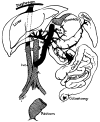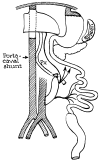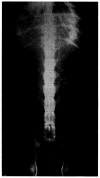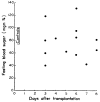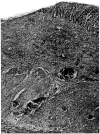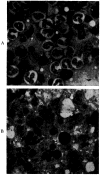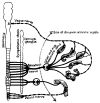Homotransplantation of multiple visceral organs - PubMed (original) (raw)
Homotransplantation of multiple visceral organs
T E STARZL et al. Am J Surg. 1962 Feb.
No abstract available
Figures
Fig. 1
Schematic view of the transplanted tissues and their anatomic relation to the host. The grafted tissues are not shaded.
Fig. 2
Addition of portacaval shunt to operation depicted in Figure 1.
Fig. 3
Abdominal roentgenogram of Dog No. 18 on the sixth postoperative day. Dog had been on oral intake for four days.
Fig. 4
Development of chemical jaundice with rise in alkaline phosphatase, seen in three of the five long-surviving dogs.
Fig. 5
Absence of jaundice in two of the five long-surviving dogs. Note rise in alkaline phosphatase.
Fig. 6
Fasting blood sugars in the five long-surviving dogs. Note usual absence of pronounced hypoglycemia.
Fig. 7
Liver after nine days, from Dog No. 18, in which jaundice did not develop. A, magnification × 65; B, magnification × 350.
Fig. 8
Liver after seven days, from Dog No. 4, in which jaundice developed. A, magnification × 65; B, magnification × 350.
Fig. 9
Donor spleen, after nine days, from Dog No. 19. A, magnification × 65; B, magnification × 350.
Fig. 10
Donor lymph node from mesentery of graft in Dog No. 26. Animal lived five and a half days. A, magnification × 30; B, magnification × 600.
Fig. 11
Small intestine of Dog No. 4, seven days after transplantation (magnification × 18). Note congestion, edema and superficial slough.
Fig. 12
Duodenal ulcer in Dog No. 18, after nine days (magnification × 25).
Fig. 13
A, bone marrow from normal dog showing active granulopoiesis and erythropoiesis (magnification × 900). B, marrow from Dog No. 26, showing a cellular specimen with extensive replacement of normal myeloid elements by a relative and absolute increase in lymphocytes, reticulum cells and plasma cells (magnification × 900).
Fig. 14
Lung from Dog No. 18, nine days after visceral transplantation (magnification × 350). Note pulmonary edema and proliferative thickening of alveolar septa.
Fig. 15
Recipient lymph node from mediastinum of Dog No. 36 after six days. A, magnification × 30; B, magnification × 600.
Fig. 16
State of denervation of multiple organ graft.
Similar articles
- [Certain new aspects of homotransplantation of tissue and organs].
LANGER P. LANGER P. Bratisl Lek Listy. 1954 Feb;34(2):202-8. Bratisl Lek Listy. 1954. PMID: 13182121 Undetermined Language. No abstract available. - [Homotransplantation of organs and tissues. 1. Homotransplantation of endocrine glands with the procedure of millipore filter chambers].
PRIARIO JC. PRIARIO JC. An Fac Med Univ Repub Montev Urug. 1960;45:107-14. An Fac Med Univ Repub Montev Urug. 1960. PMID: 14434831 Spanish. No abstract available. - Ovarian homotransplantation.
KROHN PL. KROHN PL. Ann N Y Acad Sci. 1955 Jan 24;59(3):443-7. doi: 10.1111/j.1749-6632.1955.tb45958.x. Ann N Y Acad Sci. 1955. PMID: 14362289 No abstract available. - The race between the homotransplantation of and prosthetic substitutes for human tissues and organs.
Conway H. Conway H. Bull Soc Int Chir. 1966 Nov-Dec;25(6):680-94. Bull Soc Int Chir. 1966. PMID: 4861671 Review. No abstract available. - [THE PROBLEM OF INTERACTION BETWEEN TRANSPLANT DONOR AND RECIPIENT IN HOMOTRANSPLANTATION IN MAMMALS].
EFIMOV MI. EFIMOV MI. Usp Sovrem Biol. 1964 Jul-Aug;58:131-49. Usp Sovrem Biol. 1964. PMID: 14238403 Review. Russian. No abstract available.
Cited by
- Multivisceral Transplantation for Diffuse Portomesenteric Thrombosis: Lessons Learned for Surgical Optimization.
Canovai E, Ceulemans LJ, Gilbo N, Duchateau NM, De Hertogh G, Hiele M, Jochmans I, Vanuytsel T, Maleux G, Verhaegen M, Monbaliu D, Pirenne J. Canovai E, et al. Front Surg. 2021 Feb 19;8:645302. doi: 10.3389/fsurg.2021.645302. eCollection 2021. Front Surg. 2021. PMID: 33681286 Free PMC article. - World's smallest combined en bloc liver-pancreas transplantation.
Elsabbagh AM, Hawksworth J, Khan KM, Yazigi N, Matsumoto CS, Fishbein TM. Elsabbagh AM, et al. Pediatr Transplant. 2018 Feb;22(1):10.1111/petr.13082. doi: 10.1111/petr.13082. Epub 2017 Nov 15. Pediatr Transplant. 2018. PMID: 29139617 Free PMC article. - Abdominal transplantation for unresectable tumors in children: the zooming out principle.
Samuk I, Tekin A, Tryphonopoulos P, Pinto IG, Garcia J, Weppler D, Levi DM, Nishida S, Selvaggi G, Ruiz P, Tzakis AG, Vianna R. Samuk I, et al. Pediatr Surg Int. 2016 Apr;32(4):337-46. doi: 10.1007/s00383-015-3852-3. Epub 2015 Dec 28. Pediatr Surg Int. 2016. PMID: 26711121 - The Future of Xenotransplantation.
Starzl TE. Starzl TE. Ann Surg. 1992 Oct 1;216(4):3-10. Ann Surg. 1992. PMID: 25006273 Free PMC article. No abstract available.
References
- Billingham RE. Reactions of grafts against their hosts. Science. 1959;130:947. - PubMed
- Goodrich EO, Welch HF, Nelson JA, Beecher TS, Welch CS. Homotransplantation of the canine liver. Surgery. 1956;39:244. - PubMed
- Lillehei CW, Wangensteen OH. Effect of celiac ganglionectomy upon experimental peptic ulcer formation. Proc Soc Exper Biol & Med. 1948;68:369. - PubMed
MeSH terms
LinkOut - more resources
Full Text Sources
